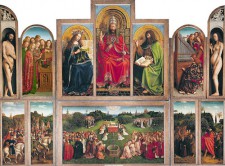Launch Creator Doctus
On 13 November 2015 a new international trajectory for artists, which leads to the title Creator Doctus (CrD) was launched at the Gerrit Rietveld Academie.
This project entails to commission an artist as part of the three year Creator Doctus research trajectory. The project is a collaboration between an art school, a social partner and possibly a financial partner. The CrD-trajectory has been set up as an international trajectory with the following partners: Ecole Europeenne superieure d’art de Bretagne, Birmingham School of Art, and the Gerrit Rietveld Academie in Amsterdam.
Creator Doctus (CrD) is a title invented to valorize a three-year research process conducted by an artist, offering a new trajectory with the so-called third cycle of higher education. The process leads towards a corpus of works or projects and entails no compulsory writing. The social partner formulates the research questions that fuel the research project.
Context
All through history exceptional artists have been underpinning their works with research. One of the earliest and most famous examples is the Ghent Altarpiece by Hubert and Jan van Eyck, which not only explored the possibilities of the new technique of oil painting, but also assembled in visual form the contemporary knowledge about the physical world. Another great example of course is Rembrandt who’s daring reinterpretation of standard classical and biblical themes based on his own research and the contacts with the scholars of his time earned him the title Pictor Doctus, a title that formed the inspiration for the Creator Doctus. More recently the work of Robert Smithson shows how research can lead to an outstanding combination of visual and written work that keeps its distance to more academic forms of knowledge. And of course many contemporary artists base a great deal of their practice on research without wanting to step into the trajectory of a PhD: Camille Henrot and Falke Pisano, to mention just a few.
Today we see many new configurations in which the research of the art practice is being boosted and valued. A case in point to this tendency is how in the last decade higher vocational education and academic institutions have grown closer, by accommodating the process of transferring and exchanging between higher vocational education and university programs among other things.
These shifts were also felt in the art world. For example, artists are being offered the chance to get a doctorate based on a combination of a dissertation and their work. (Artistic research is the term that has been created for this new hybrid area). For museums of modern and contemporary art this means that a portion of the art they show, champions a new relationship between research and practice. (For example artists give lectures or want to work on the collection or the archives).
The main goal of the Creator Doctus is to create a trajectory that runs parallel to the existing PhD tracks, and receives the same international recognition, but that valorises the artistic output of artists as valuable research without the necessary supplement of a written thesis. Obtaining the degree of Creator Doctus will offer recognition of the profession and craft of the artist. It must be emphasized that the trajectory is not a rejection of the PhD-model; it offers a new model that establishes a stronger relation between the art world and artists doing research.
Introduction to the program by Jeroen Boomgaard, Head of Research, Gerrit Rietveld Academie
Presentation of the possibility of a CrD-trajectory in the UK by Johnny Golding, Director Centre for Fine Art Research Birmingham School of Art
Presentation of the CrD-trajectory in the Netherlands by Jeroen Boomgaard, Head of Research, Gerrit Rietveld Academie
Presentation of the possible assessment criteria of the CrD-trajectory by Michael Mersinis, Lecturer Fine Art Photography, Glasgow School of Art
